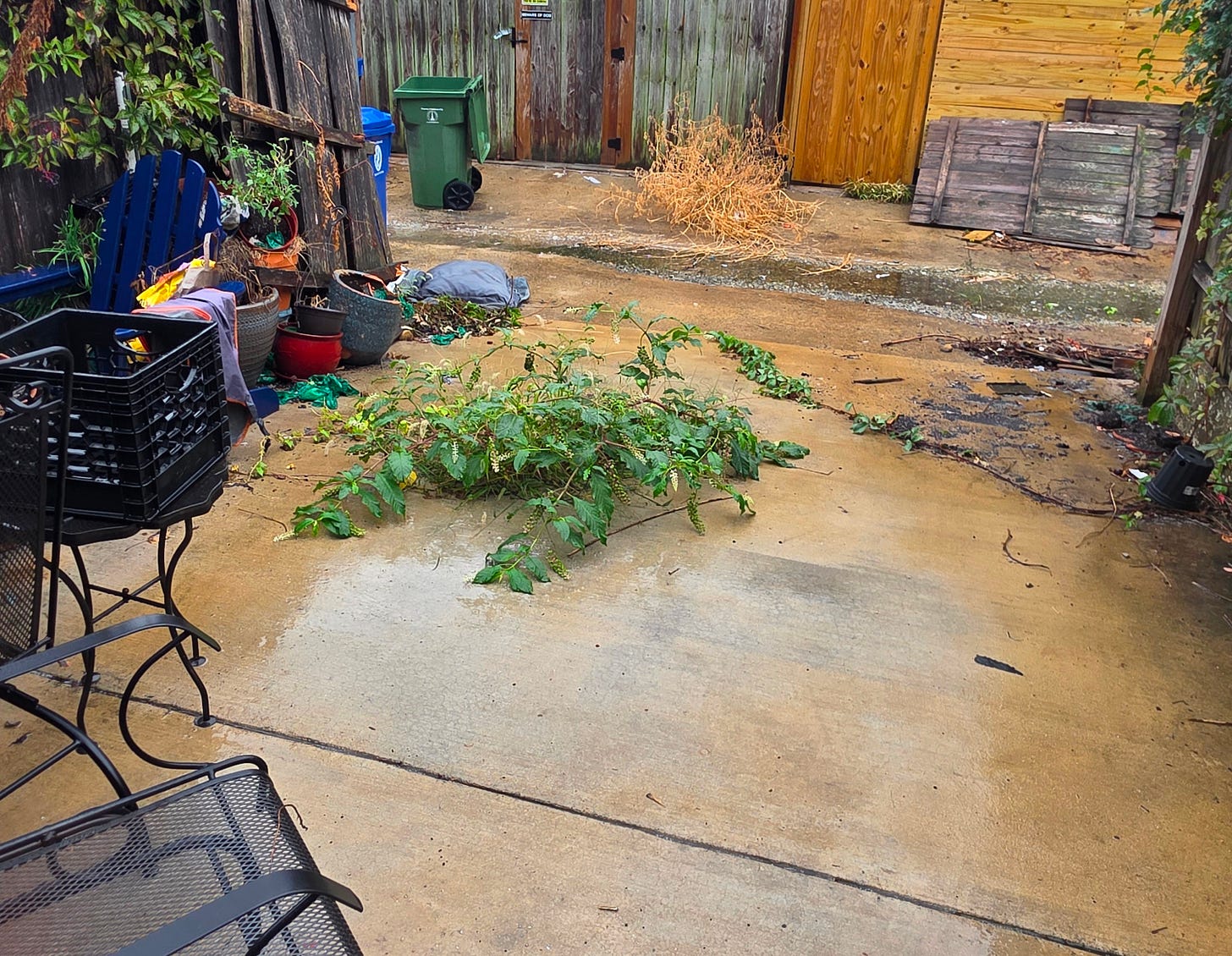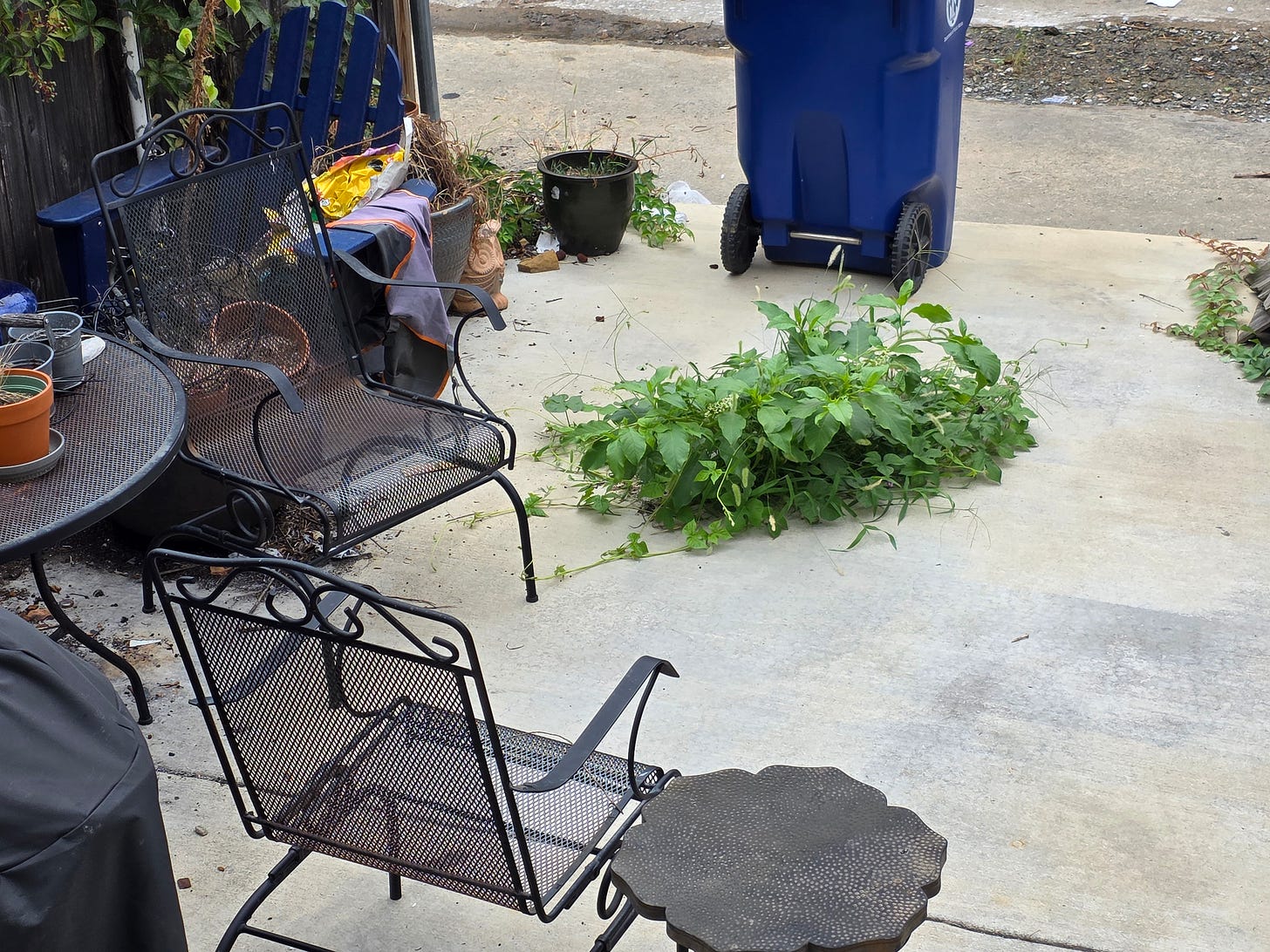4 Content Marketing Lessons From the Plant in My Parking Pad
Four simple lessons on growth, momentum, and building on solid ground — from a stubborn little plant that refused to quit.
It doesn’t take much space to grow, just tenacity.
But there’s a catch (we’ll get to that at the end).
Behind my row house is what’s called a “parking pad” here in Baltimore. After a thunderstorm knocked part of my fence down this summer, I stopped parking back there. Between the broken fence, the junk that had piled up and I had shuffled around, and the fact it’s a sauna in July and August, the space sat empty for three months.
That’s when I noticed something strange – I had a “back yard” growing.
A flower from my neighbor’s fence started to grow in the 8-inch hole in the middle of the concrete (water outlet or something).
Steel. Concrete. A dusting of dirt. That’s all it had.
After the first couple of flowers poked through, the grassy weeds started. Then a vine with berries that the neighborhood birds can’t get enough of. After three months, I had to start walking around it to take out my trash.
And it made me think about content marketing.
1. You Don’t Need Much Room to Grow
That little pocket of dirt was enough to get started.
When you’re building a business or a newsletter, the same is true. Niches aren’t glamorous, but they give you traction. Doubling down on what you already know — and who already trusts you — is the fastest way to get moving.
There’s a lot of anti-niche advice when you start writing. And while I do believe you shouldn’t lock yourself in forever (it’s not a marriage decision here), to get started pick a topic and focus. After all, almost every niche includes dozens to hundreds of sub-niches; you can always shift over time – even to a completely new niche or industry.
Steps you can take:
Start with the audience you already have — past clients, colleagues, and friends who understand your space.
Focus on one clear point of pain or topic instead of trying to cover everything at once.
Create a “starter” content series (3–5 posts or emails) that answers the most common questions in your niche from your unique point of view.
Use what you know best as your first “soil.” Don’t overthink it.
2. Make Your Own Growth
I’m pretty sure those roots punched through a thin layer of concrete to find more soil (I’ll find out if it did the next time it rains). Over time, the plant collected its own dirt and — maybe — even deepened the hole.
That’s what happens when you lead with a point of view.
Don’t sand your rough edges to fit in — those edges are what snag the attention of your people. When you stand for something, you’ll attract people who want to hear it.
Steps you can take:
Write down your three non-negotiable beliefs about your industry or craft — and use them as themes in your content.
Share your “why” story at least once a month (or at least regularly). It reminds people why you do what you do.
Don’t shy away from repetition — your consistent stance is what builds recognition. And not everyone reads everything you write, so while it might be your third or fourth take on a topic; someone is reading it for the first time.
Invite interaction: ask your readers to reply, share their version, or challenge your POV. That’s how you collect more “dirt.” As a print editor, I closed my Letter From the Editor with “Comments, criticisms, and witticisms welcomed.” I will begin doing that here too.

3. Growth Attracts Growth
The flowers made space for grass. The grass made space for the vine. One thing thriving made it easier for the next thing to take hold.
Content works the same way. Your first ten subscribers become your first advocates. Early posts, however scrappy, create openings for bigger opportunities.
Consistency compounds.
Steps you can take:
Set a minimum publishing rhythm you can stick to (weekly or biweekly is better than “whenever”).
Repurpose small wins — turn a LinkedIn post into a short email, or an email into a blog post.
Celebrate early readers and customers — highlight their stories, feedback, or wins.
Track what resonates (opens, replies, comments) and lean into it instead of chasing shiny new ideas every week.
4. Don’t Build on Rented Land
Here’s the catch: one tug, and my “backyard” was gone.
That’s exactly what happens if you build your audience entirely on someone else’s platform.
Google, LinkedIn, Facebook, Substack; they decide who sees your work and when. One algorithm change, and poof.
Your inbox list? That’s yours. It’s boring. It’s reliable. And it delivers: in fact, consumers overwhelmingly prefer to receive company communications via email rather than social or push messages (I wrote about this and other email metrics here.)
You need to use the various platforms to gain attention. But never forget that they care about their business, not yours. ALWAYS be ready to change platforms and ALWAYS be building your list.
Steps you can take:
Make email your home base. Use your posts, videos, and social shares to increase the size of your list. (Also remember it’s not just “a list;” it’s your customers and potential customers.)
Offer a simple, useful lead magnet — checklist, template, educational email course, quick guide, the possibilities are endless — to encourage sign-ups.
Regularly back up your list; don’t leave it locked inside one platform.
Use social to amplify your work and even to build relationships, but never forget you own the relationship via email.
That little plant reminded me: growth doesn’t need perfect conditions. It just needs space, tenacity, and the right foundation.
And for your business, that foundation is your customer’s inbox.
Want help setting that foundation?
That’s exactly what I built Newsletter-in-a-Box for. I’ll help you launch a newsletter without the headaches: strategy, design, setup, and the first issues ready to send. No rented land. Just your voice, your audience, and a channel you control.
Let’s get your newsletter started → read more details here or bryant@simplyusefulmarketing.co.




